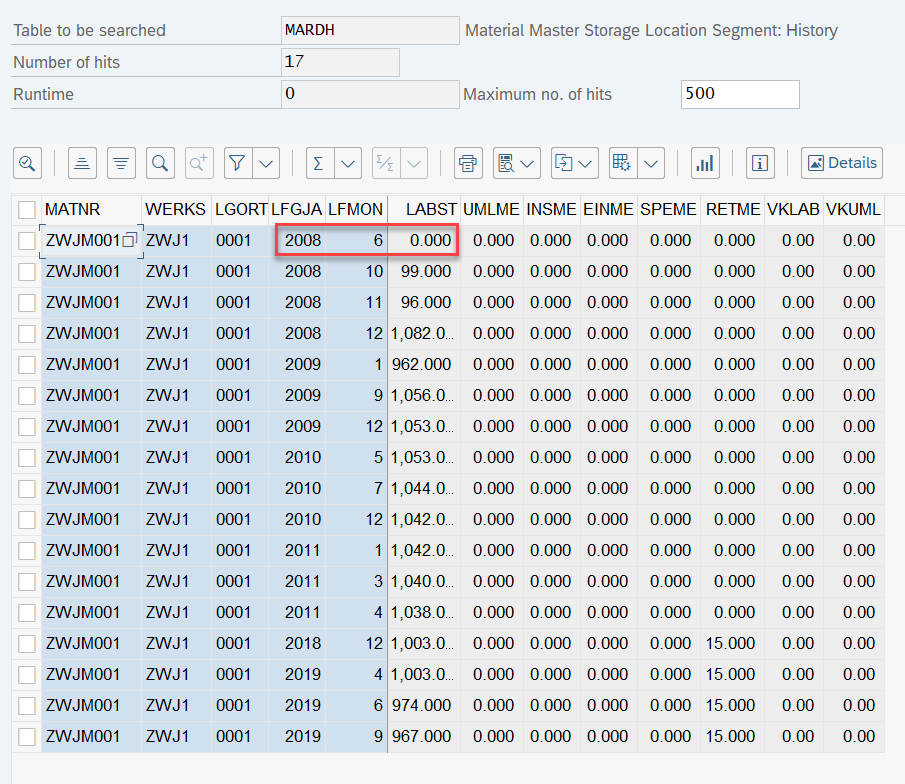
- SAP Community
- Products and Technology
- Enterprise Resource Planning
- ERP Blogs by SAP
- MARDH in SAP S/4HANA On Premise is different from ...
Enterprise Resource Planning Blogs by SAP
Get insights and updates about cloud ERP and RISE with SAP, SAP S/4HANA and SAP S/4HANA Cloud, and more enterprise management capabilities with SAP blog posts.
Turn on suggestions
Auto-suggest helps you quickly narrow down your search results by suggesting possible matches as you type.
Showing results for
Advisor
Options
- Subscribe to RSS Feed
- Mark as New
- Mark as Read
- Bookmark
- Subscribe
- Printer Friendly Page
- Report Inappropriate Content
05-12-2020
11:29 PM
Introduction:
This blog will show you how different MARDH between SAP S/4HANA and SAP ERP for MM Consultants.
This is valid for S/4HANA any on premise version.
MARDH in SAP ERP:
If the quantity is same in contiguous periods, only the oldest data is created in MARDH in SAP ERP.
MARDH in SAP S/4H
Although the quantity is same in contiguous periods, the MARDH data is created for each periods in SAP S/4HANA. MARDH in SAP S/4HANA is called the compatibility view. MARDH was unavailable in SAP S/4HANA. For compatibility reason MARDH is generated from table “MATDOC_EXTRACT” via compatibility view function.
How to see the compatibility view:
Execute Transaction code: se11
Choose Menu>Extras>Replacement Object
You can see the compatibility view. Compatibility view is constructed CDS view.
How to see the CDS View contained:
Execute ABAP development tool(ADT).
The compatibility view (Replacement Object) “NSDM_E_MARDH” is generated from CDS View “nsdm_e_mardh_per” and CDS View “nsdm_e_mardh_agg”.
CDS View “nsdm_e_mardh_per” is generated from the table “MATDOC_EXTRACT”.
CDS View “nsdm_e_mardh_agg” is generated also from the table “MATDOC_EXTRACT”.
Conclusion:
You can understand how different MARDH between SAP S/4HANA and SAP ERP.
SAP note:
2600024 - Create a Material, updates History Tables, MCHBH, MARCH and MARDH, with past Years (LFGJA)...
2206980 - Material Inventory Managment: change of data model in S/4HANA
Brought to you by the SAP S/4HANA Customer Care and RIG
This blog will show you how different MARDH between SAP S/4HANA and SAP ERP for MM Consultants.
This is valid for S/4HANA any on premise version.
MARDH in SAP ERP:
If the quantity is same in contiguous periods, only the oldest data is created in MARDH in SAP ERP.

MARDH in SAP S/4H
Although the quantity is same in contiguous periods, the MARDH data is created for each periods in SAP S/4HANA. MARDH in SAP S/4HANA is called the compatibility view. MARDH was unavailable in SAP S/4HANA. For compatibility reason MARDH is generated from table “MATDOC_EXTRACT” via compatibility view function.

How to see the compatibility view:
Execute Transaction code: se11
Choose Menu>Extras>Replacement Object

You can see the compatibility view. Compatibility view is constructed CDS view.

How to see the CDS View contained:
Execute ABAP development tool(ADT).
The compatibility view (Replacement Object) “NSDM_E_MARDH” is generated from CDS View “nsdm_e_mardh_per” and CDS View “nsdm_e_mardh_agg”.

CDS View “nsdm_e_mardh_per” is generated from the table “MATDOC_EXTRACT”.

CDS View “nsdm_e_mardh_agg” is generated also from the table “MATDOC_EXTRACT”.

Conclusion:
You can understand how different MARDH between SAP S/4HANA and SAP ERP.
SAP note:
2600024 - Create a Material, updates History Tables, MCHBH, MARCH and MARDH, with past Years (LFGJA)...
2206980 - Material Inventory Managment: change of data model in S/4HANA
Brought to you by the SAP S/4HANA Customer Care and RIG
- SAP Managed Tags:
- SAP S/4HANA,
- SAP S/4HANA Private Cloud
Labels:
5 Comments
You must be a registered user to add a comment. If you've already registered, sign in. Otherwise, register and sign in.
Labels in this area
-
Artificial Intelligence (AI)
1 -
Business Trends
363 -
Business Trends
21 -
Customer COE Basics and Fundamentals
1 -
Digital Transformation with Cloud ERP (DT)
1 -
Event Information
461 -
Event Information
24 -
Expert Insights
114 -
Expert Insights
153 -
General
1 -
Governance and Organization
1 -
Introduction
1 -
Life at SAP
415 -
Life at SAP
2 -
Product Updates
4,685 -
Product Updates
214 -
Roadmap and Strategy
1 -
Technology Updates
1,502 -
Technology Updates
89
Related Content
- Update of the SAP Activate Roadmap for SAP S/4HANA (on prem) upgrades with the Clean Core Strategy in Enterprise Resource Planning Blogs by SAP
- How to find field technical details in S4HANA Cloud solution in Enterprise Resource Planning Q&A
- Integration of SAP Service and Asset Manager(SSAM) with SAP FSM to support S/4HANA Service Processes in Enterprise Resource Planning Blogs by SAP
- Building Low Code Extensions with Key User Extensibility in SAP S/4HANA and SAP Build in Enterprise Resource Planning Blogs by SAP
- migration jobs in S/4HANA Cloud troubleshooting in Enterprise Resource Planning Q&A
Top kudoed authors
| User | Count |
|---|---|
| 12 | |
| 11 | |
| 7 | |
| 6 | |
| 6 | |
| 4 | |
| 4 | |
| 4 | |
| 4 | |
| 3 |